
|
|
|
Search our site
Check these out    Do you have an entertaining or useful blog or personal website? If you'd like to see it listed here, send the URL to leon@pawneerock.org. AnnouncementsGive us your Pawnee Rock news, and we'll spread the word. |
Too Long in the WindWarning: The following contains opinions and ideas. Some memories may be accurate. -- Leon Unruh. Send comments to Leon August 2007The secret history of Pawnee Rock[August 31] I always think of the house at Centre and Bismark as Harry Lewis' house, and not the Stimatzes' house as it is now and not as the Mosberger house as it once was. Someone moving to Pawnee Rock last year might assume the one-story house at 412 Santa Fe was always the Creed place, when for decades it was the Unruh house, which my parents built and where I grew up. Oldtimers (old compared to me) know that before our house was built in the 1950s there was a basement house there, and before that it was a vacant lot with several previous owners. One of the lot's owners was Wilson Zieber, who owned a nursery that produced many of the grand elms that once shaded our hometown in profusion. The big house south of city hall (the former Methodist Church built on the ashes of the previous church) is owned by the Chapman family. In my time, the Frank Jones family paid the taxes. In the 1940s, it was the Granthams' home. The Joneses in the late 1960s operated the Midget Malt Shop, which was in the little building immediately south of the old Betty's Cafe at Centre and Cunnife. Back in the days when all photographs were black and white, Otto Kopke ran the Consolidated Scale at that little building, weighing farm trucks and grain for Pawnee Rock's several elevators. The Gano, Moses, Lewis, and Baker elevators that lined the tracks are gone, lost in the dust storm of time; so is the Lindas Lumber Yard, which supplied the goods that Pawnee Rock was created from. Maybe you bought some lumber there from manager Bill Levingston; Bill also was the fire chief when the fire station was in the red brick building next door to my house. Now the firetrucks sit in a metal building on the site of the old lumberyard. My dad, carpenter Elgie Unruh, bought plenty of wood from Bill. Dad had a shop directly south of the lumberyard and directly east of the grocery store, which eventually became the American Legion hall. The American Legion's previous home was a basement at the south end of Centre. The family that constructed an above-ground house over that basement used lumber from the farmhouse my dad grew up in. You and I know the Legion hall/Carpenter-Hixon-Carris grocery store building, but our parents know where the other (Morris) grocery store was. The J.D. Carpenter house at Santa Fe and Walnut is gone, Al Carris once ran for president from his house at Bismark and Rock, and the Hixons built the house south of the old Mennonite parsonage and on the site of the driveway to the earlier high school. The Hixons sold their house to the Countrymans, who, if I remember right, previously lived at 610 Centre and then on Pawnee in a frame house that has been replaced by a trailer house. Eventually, the Countrymans' house became the Eppersons' house. The now-former Mennonite parsonage, at Pawnee and Houck, wasn't always a parsonage. It used to house a branch of the Spreier family; daughter Joan got married and moved into the house exactly a block south of there, and that house is now owned by the Woodrows. Earlier, it was owned by Norm and Margaret Converse; he had a financial services office in what is now the back room of the post office (itself a former bank), and she was the postmaster. After Margaret's tenure, Virgil Smith was briefly the postmaster, and later (after Roger Unruh) Joan became the postmaster. (My mom, Anita, was Roger's assistant, and Dad later ran the mail route as Virgil had before him.) There are connections like that all over Pawnee Rock, hidden ties between families and homes and jobs going back decades. Every place in town has a secret life. Fairly big vegetables
A 56-pound cabbage, a 19-pound turnip, and oversize rhubarb stalks are part of Alaska's largesse. [August 30] The Kansas State Fair has bread and cattle. The State Fair of Texas has cattle and cooking. The Iowa State Fair has politicians. And the Alaska State Fair has vegetables bigger than your child. 
This year's Alaska fair has a 56.5-pound cabbage and a world-record 84.7-pound kale, and last year's fair had a 1,109-pound pumpkin. Don't be intimidated -- these are genetic outliers created for gardeners who have the long days and cool weather needed for cruciferous gigantism. But a different oversize vegetable always gets my attention, because I can relate to it in this land far from Pawnee Rock. It's the zucchini. (Record: 29.65 pounds.) Anybody who has lived the garden lifestyle knows how zucchini grow pleasantly until you've had your fill, and then they spring forth like toads in a plague. If you let zucchini grow until late summer, they can be as big as a gardener's arm. As a boy, I abused our unwanted zucchini. I'm not proud of it, but I'm not ashamed either. I threw them onto the ground and cracked them open. I shot arrows into their bready interiors. I watched them turn yellow and rot on the vine until there was nothing left but a Hindenburgish veggie skeleton. And I love zucchini. I'm the only one in our household who buys it, although Sam, who is learning to cook, finds happiness in chopping the zucchini's born-to-be-sliced fruit. The boys want to grow cucumbers next summer in the little sunny space between the birches and the house, and maybe we'll get a few cabbages too. There probably won't be any zucchini. When I tire of zucchini I can simply stop buying it. Unlike a real gardener, I don't have to leave a bag of zucchini on the counter at work in the hope that somebody will relieve me of the eighth sin -- wasting food. Bruce Kraisinger: We have a new Friend of Pawnee Rock -- Bruce Kraisinger, Class of '71. He now lives in Salina and is a locomotive engineer for the Union Pacific Railroad. You may remember his siblings, Shari and Mark. The Kraisingers lived in a house on Pawnee Avenue two houses east of Rock Street on the north side. I see the moon and the moon sees me [August 29] Early Tuesday I stood in our dark street with my binoculars and watched Earth's shadow eat the moon. While I was staring at the silvery moon, I realized I had not remembered how beautiful it was. Look at that big crater on the bottom, and that splash from the meteor strike. Where did the Apollos land? What on Earth made me forget the craters and plains? I want to go explore the moon. It's unlikely that I'll make the trip, of course, although your kids and mine might one day set up shop on the Sea of Tranquility, 238,000 miles from Pawnee Rock. Maybe the moon is the perfect place to wish I could be. Because I can't get there, there's no chance I'll ever wish to leave it. Free ticket to the circus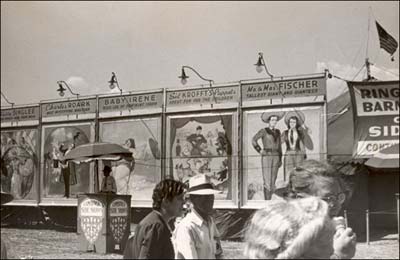
[August 28] It's a childhood legend that every kid wants to join the circus. For Leon Miller, who certainly wasn't afraid of hard work, the dream came true when the Ringling Bros. and Barnum & Bailey Circus train pulled into Great Bend 60 years ago this week. He sent us this photo taken by Dean Ross (and two on the homepage) so we could better see what it was like on Friday, August 29, 1947. Did you go? Here's what Leon wrote: Working at the circusBack in the summer of 1947, the circus (Ringling Bros. and Barnum & Bailey) came to town; Great Bend, actually. I was 13 at the time and had spent a Friday night with my Aunt Grace, who lived in Great Bend, anxiously awaiting the circus, which was going to be performing on the north side of town the next day. My aunt lived on Park Street, across from the county jail. I got up early and walked down to the Great Bend depot to watch the circus unload. I was standing there observing the cages and paraphernalia coming off the railroad cars when this gruff-looking guy came up to me and asked, "Hey, kid! You want to get into see the circus?" I replied, "Sure. How?!" He said, "I need help setting up the tents and I'll give you a free ticket to get in plus a hot dog and a soft drink if you come with me." Man, was I thrilled! I joined a bunch of other kids who had accepted the offer and we followed the circus right up Main Street. I worked my tail off in the process but it was worth it! It was an experience I'll never forget. The same circus comes to Dallas every summer about this time but there isn't the same aura that I experienced as a kid. They perform in American Airlines Center, and rather than looking up at the trapeze artists, you're looking down at them. It's just not the same thing! Putting Legion money to good use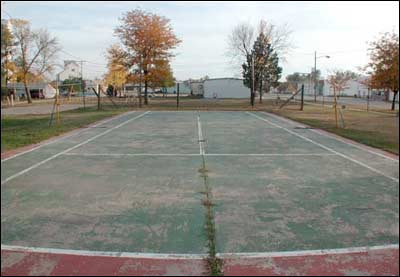 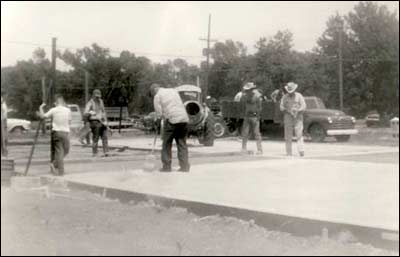
Before the tennis court was here, Pawnee Rockers sat on benches and faced south toward a screen put up by the long wall of the lumberyard. The lumberyard is gone, torn down in 1990 and replaced by the empty space, playground equipment and a metal-shed fire station. The tennis court was poured by a crew of local men and boys in the late 1940s or the early 1950s. [August 27] The outdoor movies of the 1930s and 1940s made a big impression on a generation of youngsters: Don Ross, Virgil Smith, Pat Wycoff Croff, and Leon Miller all tell of evenings with the stars, under the stars. Leon sent this note of his recollection of how the tennis courts came to be installed and about the organization that may have put them there: The American LegionI remember frequenting the movies Virgil Smith describes in Friday's column. They were a welcome relief to the week's toils and labor (as if a kid had much labor). As to the tennis courts, I seem to recall they were a project of the local Albert O. Tacker Post of the American Legion. They were constructed sometime in my high school years (1947-51). I remember playing tennis there many times. After WWII the Legion became a very popular organization in Pawnee Rock and sponsored many money-raising projects in the community. One of the most successful projects was an annual "Turkey Shoot" that took place in November, shortly before Thanksgiving. Someone donated the use of some land just east of town, where the sewer plant now stands, and members of the Legion went out and built a trapshooting range. It consisted of a "pill box" where someone (including myself on occasion) would sit inside and place clay pigeons on the trap apparatus. The shooters would line up at their posts and when we heard the word "pull," we would release the clay pigeons and the shooters would fire at the target. There were seven firing positions and whoever hit the most targets would win a turkey. We were protected by 8' of concrete so never got hurt. The shooters would pay for a chance to win a turkey and the event brought in a lot of people and money to the community. If a person was not a skilled hunter or shooter the Legion had a card game setup in the Legion Hall, which was directly across the street from where I grew up. They had poker, pitch or pinnocle games and the drinks and "gambling" flowed abundantly. This generally took place the night before the Turkey Shoot in order to get money from both the shooters and the card players. The event created quite a stir as many in the religous community were obviously opposed to the chicanery and gambling that went on. At the same time, they welcomed the money that was given back for community projects (such as the tennis courts). One has to remember these things were sponsored by veterans who had given 4 years to bring the country out of the War and many felt justified to enjoy a brew or two after a hard day's work. You might say the Legion was the equivalent of the Kiwanis Club or Rotary Club in terms of service to the community at the time. I don't think Pawnee Rock even had a Lions Club back then. The pocket horse[August 26] I've ridden horses before, but I don't make a habit of it and I never did it like Virgil Smith and the boys of those days. Among my steeds were the horse that I think was owned by Sharla, Darla, Marla, and Monica Johnson in Pawnee Rock and a couple of Shetland ponies walking in tethered circles in Larned and Great Bend to pay for their sins. 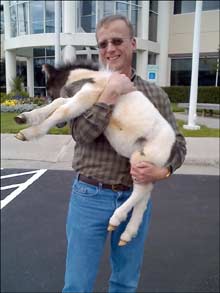 Friday, I repaid my debt to horses. I gave one of them a ride. It was, as you'd expect, a miniature horse, and it was a colt besides. I think it weighed 25 pounds or so. The colt's owner brought it by the newspaper to thank us for printing a photo of it next to a duck. A bunch of us gave in to the temptation to go out and pet it, and a few of us got to hold it. It leaned back in my arms and put its head on my shoulder. I think it liked me. Normally, I'd put miniature horses in the same freak-show category as emus and ostriches and chinchillas grown where there's no need for them and where it's blindingly obvious the owners are doing it in the dream of a quick buck. But now the truth is out -- I'm a softie. I'd like to get a horse that size, but we already have a dog that's bigger than the colt is ever going to be. A photo I like: No. 49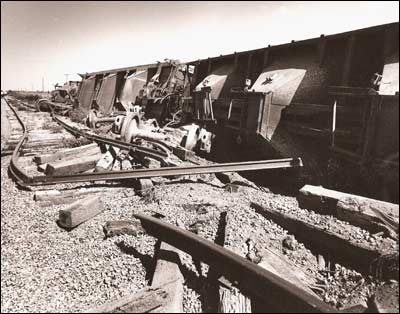
[August 25] We heard about the train wreck over the police scanner as we sat in the Larned Tiller and Toiler office late one summer afternoon in 1975. Nekoma, where the derailment happened, was out of our circulation area and there was no reason to think we'd sell any papers because of it, but a train wreck was news. Bruce Janssen and I loaded ourselves into his car and drove north. Bruce reported the story, and I looked around and took pictures. I had been around trains all my 18 years; you don't grow up in Pawnee Rock without having trains in your blood. But this was the first time I had seen one on its side. The wheels and their trucks were out from under the hopper cars, the tracks were twisted, and grain was all over the ground. Until that afternoon, I had had no idea of the weight and momentum of railroad cars. I was surprised and a little disappointed by how normal things were, except for the obvious problem. Birds were singing, workers were not yelling, no one was hurt, and there were no fires or sirens -- it was an inconvenience to the railroad company, but it wasn't a disaster. In my newspaper job now, I deal with a world of daily disasters, some of almost unimaginable proportions. By all rights, we should be helpless with empathy for the victims, and we do feel for them. Still, this derailment was an important part of my grown-up education: I began to realize that the actual disaster, no matter how impressive, lasts a moment or two and then we all start cleaning it up and getting on with life. It's all we can do. Movie-star horses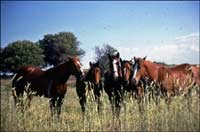 [August 24] Virgil Smith, who sent us the equine photo on the homepage, grew up with horses on the Elrick Smith farm three miles northwest of Pawnee Rock. Horses meant a lot to farmers and kids in the 1930s and '40s -- especially to kids who attended the movies. Virgil reminisced about his inspiration: "When I was growing up, I had a horse that I could throw a saddle on and tear around, pretending to be one of the cowboys that I had seen in a movie, but my horse was too docile -- not like these handsome guys. Why, if I would have had one of these beauties, I could have been Tom Mix . . . or Gene Autrey . . . or LASH LARUE! "Lash wasn't too well known, but you wouldn't believe what he could do with a whip. I had a whip that was made by nailing a rein to a wooden handle. I could make it crack real loud, but just couldn't do the things that Lash could. "I got to know these heroes by watching them in the free movies shown weekly during the summer on the vacant lot north of Lindas Lumber in Pawnee Rock. We sat on seats made with wood planks on concrete blocks. I'm sure they were furnished by Henry Svatos, the manager of Lindas Lumber. He was a great old guy -- hard to understand since he was foreign born, but a real American and supporter of the community. "When it got dark enough, the people would be seated and the projector started. The main feature was often a Western, but before it was shown, there would be the serial chapter. It was like a melodrama, full of action and suspense and just when it got to the most critical part, there would be a sign on the screen 'to be continued.' If you wanted to know what happened, you had to come again next week. "If you had a nickel and were lucky, you might be able to go across the street to the drugstore after the show and get a drink like a cherry coke and, if you had a dime, you could have a Snickers or Payday or a bag of Planters, also. What a deal!" I asked Virgil when the movies were shown and when the tennis court was built. (Now, of course, the lumberyard and drugstore are gone.) "I think that the movies were shown in the latter '30s -- maybe they were started sooner. The tennis courts must have been poured in the latter '50s." Pawnee Rock and the PIPM Ultimatum[August 23] This is the part of the press release that caught my eye: "Pawnee Rock emerges as the model community and faces less persecution from the powerful organization due to the quality of the residents and their lifestyle. The citizens learn of the devious organization and figure out how to survive against impossible odds." And then I read the rest of the message from Brad Tew, telling me about his new book, "PIPM Ultimatum." (Review) Here's more: 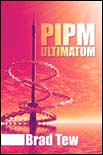 "The story is about a powerful organization that is formed by influencial leaders throughout the world to solve serious problems by imposing radical solutions. They ultimately decide to reduce world population by 80 percent and face opposition from various people and special interest groups." I was curious about why someone would pick Pawnee Rock to be the surviving cultural center of the new world. I was flattered, as I'm sure we all are, but I wondered: Had, in fact, the author ever been to Pawnee Rock? So I wrote to the author, Brad Tew, and asked him that and a few other things. He responded with a nice note: "I'm 49 years old married with five kids, from Lake Tahoe, California & currently live in Utah with a ranch in Idaho. I have worked in a number of professions including Real Estate, Artist, U.S. Navy & Archaeologist, and have lived all over the U.S. "My aunt Marilyn Phemister lived in Pawnee Rock and ran a book store with her husband Chuck before moving to Larned. You may know her. "I am also a fingerstyle guitar player and have hoped to play in the national champioinship held in Winfield, KS each year. "I liked the idea of a small town centrally located in the U.S. that was isolated, stable and conveyed an all-American image. Since the story takes place in the future, I was able to embellish quite a bit. "This is my first published book and I felt compelled to write it last year due to my personal frustration with many problems facing the world today that continue to get worse and the helplessness of not being able to do anything to help. By writing this book, I create the opportunity for public awareness and a way to use controversial subjects to allow dialogue for positive change. "The project turned out to be more difficult and time consuming than I expected, but I am pretty happy with the finished product. It will be interesting to see how successful it turns out. "I hope to publish two more books in this series, and I devote much of my time now to writing, painting and music, as well as, numerous hobbies. "I love to travel and would love to go to Pawnee for a book signing some day. The book is considered Sci Fi by the publishers but has a lot of drama, adventure, mystery, suspense and action. I also included a surprise ending. OK, readers: You can find a little more about PIPM Ultimatum at Brad's publisher's site. Find the search box on the right side of that homepage and type in "Brad Tew" to find his $24.95, 294-page paperback. The "PIPM Ultimatum" could be the biggest literary event for our hometown since Truman Capote came through when he was writing "In Cold Blood." Let's wish Brad well. About the Chapman/Showalter question: Anita Byers (my mom) read yesterday's question from Laurie Chapman and sent this note: "I don't think Glenna was a Chapman. I think her father lived with them for a time. Kenneth and Glenna married young and had their daughter Evelyn, who made them grandparents when Glenna was 34. "Evelyn married a Reece from Rozel, was widowed and later lived in Wichita." Looking for Showalter and Chapman[August 22] Yesterday's entry about photography mentioned Kenneth Showalter, the photographer we all knew in the 1960s and '70s. He lived halfway between Radium and Pawnee Rock and seemed to be everywhere when it was picture time. So here's the question: Could he be related to Laurie Chapman? You remember Laurie, who grew up near Radium and went to Macksville High School, and whose search for the old Chapman house in Pawnee Rock was generously answered by Ruth Ann French Sessions. Yesterday, Laurie wrote: "Was Mr. Showalter married to a woman with the name of Chapman? My grandfather was raised by his grandparents. His mother married a Showalter and I believe moved to the Hutchinson area. I wonder if he is the gentleman. I think they met in the Pawnee Rock area but could not be sure. It was not discussed much but I would like to know." Laurie has run into one of the interesting hurdles of tracing ancestors: The knowledge that "everyone knows" sometimes isn't passed along. "I was not even told that my grandfather was raised by his grandparents until the last 5 to 10 years. I just know that he was left and his mother married a Showalter. There were several other half siblings that I wanted to try to find out about." Can anyone help Laurie? Dollar Night at the depot: About 30 people showed up and bought around $70 worth of grilled meat and salads last week at the fundraiser for the city park, reports city councilman Gary Trotnic. Next up: The Santa Fe Trail Race, which will come through Pawnee Rock on Monday, September 10. Darkroom days: Leon Miller of Dallas, who sent Dean Ross' photo of the car on snowy Cunnife Avenue, says he's another fellow who had a home darkroom. "I spent many an hour in the winter developing and printing photos taken around town and at school events. However, I think I destroyed most of what I had. I have always had an interest in photography and in fact inquired into the aspects of making a living at it." He decided to stick with architecture. Two to a seat: That was the fastest summer ever. Already we're having to slow down for school zones. Well, not in Pawnee Rock anymore, but you know what I mean. Cheryl Unruh's column in the Emporia Gazette this week recalls her childhood days of riding a Pawnee Rock school bus. Here's how Riding the Route starts: "School buses are stirring up dust in the countryside. "And they're cruising around town, too. One just drove past my house carrying a thousand pounds worth of children. "It's been many years since I climbed aboard one of those yellow buses and entered the canyon of green vinyl seats. "I was lucky enough to ride because I had friends in high places: my dad was a bus driver. For 18 years he drove bus No. 4 for the Pawnee Rock Schools. . . ." Snapshots of the way we live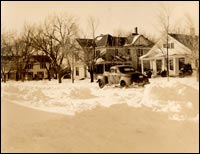
[August 21] The photo of the snowy scene was a pleasure to see -- and not just because it looks cooler than this week's heat. It recalls the day when people took fewer photos but made them count. Cameras were brought out for special occasions, such as anniversaries, ceremonies, fires, and blizzards. Often the photos were developed at home, as rural mail carrier Dean Ross did with this photo, and given to friends. His nephew, Don Ross of Dodge City, has sent us quite a few of Dean's photos over the months. Don himself was an accomplished and busy photographer, and we've also enjoyed his work. I hate to put myself in the same category as those guys, but I too had a darkroom at home. So did the Mr. Schmidt who lived a half-mile west of the salt plant; I acquired some of his darkroom tools when he gave up the hobby. Kenneth Showalter, south of town, had a darkroom. Virgil Smith took slides, and Elgie Unruh always had a camera (there must be something about mailmen and cameras). For Mr. Showalter, it was an income. I made a few bucks off photography, and with Mom's financial help I did something creative that opened the door to journalism. When I moved away from home, sister Cheryl used my darkroom, but she chose a different path in life. My pictures remain, in negative form or in boxes but without much journalistic value. That's not to say they're worthless. Although I didn't take them with history in mind, they're one version of Pawnee Rock in the 1970s, as Dean's and Don's are from the 1940s and 1950s. Every picture says something about a building, a family, or a neighborhood. That brings us to you, the gentleman and lady and inquisitive student with a digital camera. You are the ones recording the Pawnee Rock of the 21st century. Your photos of downtown or the street dance or the houses down the street may not seem like much today, but think ahead 10 years, or 30. Make photos that show life in our hometown and pass them around. Like the photographers of yesteryear, you'll be remembered for what you thought was interesting enough to keep forever. How Pawnee Rock got its first house[August 20] Drive around Pawnee Rock, especially on Cunnife Avenue, and you'll see several first-of-the-20th-century houses. The oldest house in Pawnee Rock, though, is gone and we don't even know for sure whether it was made of sandstone, sod, or wood. Sheila Sutton Schmidt's book, "Pawnee Rock: A Brief History of the Rock," tells the legend of how the first house was built: Shelter at Pawnee Rock for Founders of the Town"It was in the spring of 1872 that fourteen young men from Kentucky arrived by train in Russell, Kansas. They planned to walk half way to Pawnee Rock in one day. However, the creeks were dry along the way. In seeking water, they walked the whole fifty miles with an overnight stop. About midnight they arrived at Pawnee Rock. "The Rock itself had not been blasted away for building material at the time the group of Kentucky boys arrived. A stone stockade at the base of the Rock was the only structure around at that time. The group built the first house at Pawnee Rock. It was fourteen by sixteen feet in size. They dug the first well. They laid the foundation for the Town of Pawnee Rock. 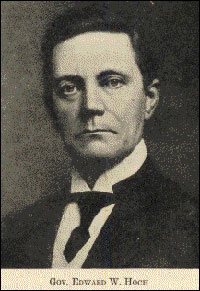
"We know the name of only one of the fourteen young men from Kentucky. Edward W. Hoch told the story about the beginning of the town at the foot of historic Pawnee Rock for which it was named. Later he became Governor of Kansas." Strictly speaking, Hoch was already a Kansan when he came to Pawnee Rock, having moved to the vastly vacant Sunflower State in 1871, when he was 21 or 22. But perhaps he still thought of himself as a Kentuckian from Danville. He evidently didn't think of himself as a Pawnee Rocker for long. In 1874 he moved to Marion and farmed, then gave up the plow and bought the newspaper there. I don't know whether it's still in his family, but it was in the 1980s. He was in the Kansas House of Representatives for four years in the late 1890s and was elected governor in 1905 and again in 1907. He is described as a "staunch Republican." He came back to Pawnee Rock in 1912 and delivered the keynote address during the dedication ceremony for Pawnee Rock State Park. He died in 1925. Well, we think he came back. His Kansas Skyways biography doesn't mention anything about starting out in Pawnee Rock. I should point out that I have a vested interest in the legend of Edward Hoch's founding of Pawnee Rock. A joy of my college career was becoming friends with one of Hoch's great-great-grandsons, Jim Hoch of Marion, who was my roommate one year. More Pawnee Rock stuff: Cheryl Unruh posted some photos of Pawnee Rock and the Barton County Historical Museum on FlyoverPeople.net. Council member resigns: The Pawnee Rock News, the beloved newsletter of our hometown, mentions in the city hall minutes that the council has accepted the resignation of Walt McCowan. Walt was the council's only holdover from the previous council. The accidental relic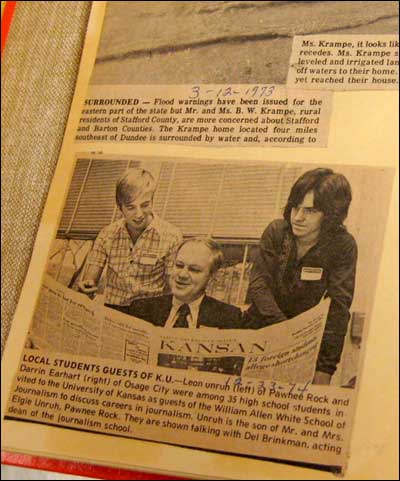
This photo, now in a scrapbook at the Barton County Historical Museum, originally appeared in the Great Bend Tribune December 23, 1974. It shows Leon Unruh, Del Brinkman, and Darrin Earhart. [August 19] My sister, Cheryl, and her husband, Dave, visited Dad and Betty in Great Bend yesterday and stopped by the Barton County Historical Museum. While browsing through scrapbooks that had been willed to the museum, Cheryl discovered that I am now a museum relic. She sent along a pair of photos that ran in the Great Bend Tribune in 1974 and 1977, during my Macksville High and University of Kansas days. The shots were handouts sent by KU to newspapers; you see such photos regularly in your newspaper because running handout photos is cheaper than paying a photographer or reporter to scrounge up news. And besides, the home folks love the photos. People buy papers more often when their face or name or their kid's face or name appears in it. Now, you and I may cut out and collect our own press mentions. I know I have a copy of that 1974 photo of me and the dean of journalism. But the surprise to me is that anyone else clipped and saved a photo of someone who probably didn't know her. What made the photos so interesting and save-worthy? Was it me, or KU, or something else? Well, now I'm part of the historical museum, and proud of it. Don't roll your eyes. You may be there too, lurking behind the cover of a diligent reader's scrapbook. 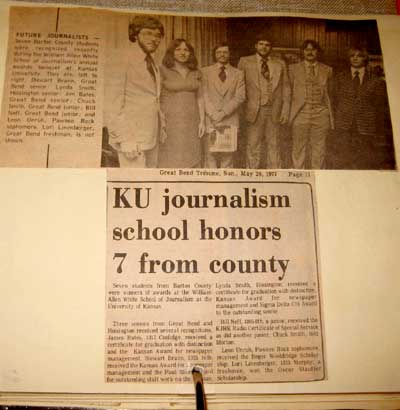
The photo now in a scrapbook at the Barton County Historical Museum originally appeared in the Great Bend Tribune on May 29, 1977. It shows (from left): Stewart Brann, Lynda Smith, Jim Bates, Chuck Smith, Bill Neff, and Leon Unruh. Lynda was from Hoisington and I was from Pawnee Rock, but the rest were from Great Bend. Lori Linenberger from Great Bend also was honored but wasn't in the photo. A photo I like: No. 48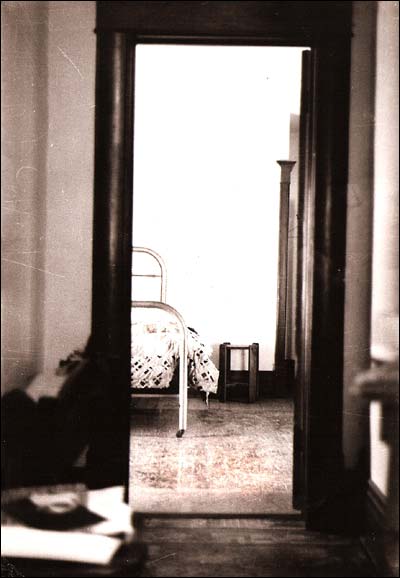
[August 18] This was the doorway into my aunt Juletha's bedroom at our Unruh grandparents' house north of Pawnee Rock. The room was upstairs; you can see the stairwell's newel post on the right side of the photo. It was the only room in the house with windows facing both north and south. The house was built by Peter A.R. Unruh in 1906, I think, so the rooms were first lived in by young Otis and his siblings. Otis got the house and married Lena, and they became the parents of Wayne, Juletha, Elgie, and Laramie. The house was built of wood and plaster and determination and, like most of the turn-of-the-century farmhouses, with very little insulation. All four of the Unruh kids slept upstairs in three bedrooms. When we Unruh and Fox grandkids -- Juletha married Herman Fox and lived in Great Bend -- stayed there overnight in the winter in the 1960s and '70s, we used lots of blankets. There was no plumbing upstairs; it would have frozen. In the evening, Grandma (Grandpa was gone by then) would feed us, amuse us, and send us to bed, but we'd gather in this room and play cards or tell stories or make pretend movies: While one of us waved a flashlight spasmodically from the bed, another of us lying on a cedar chest across the room would rise Mummy-like and cast spooky shadows on the wall. The adornments were simple: a handmade nightstand, tired linoleum curling on the edges, a lamp on a dresser behind the door, and the cedar chest. The quilts were made of hand-stitched blocks. Behind the wall behind the bed was a walk-in closet, and behind that was a storage room where Grandma kept old Grits and Christmas decorations under a layer of dust. When this photo was taken, the house was nearly 70 years old. Within 15 years of this photo, the farm was sold out of the family to pay for Grandma's nursing care and the house was torn down. The ID bracelet[August 17] ID bracelets were the rage when I was in sixth grade. Heavy silver-plated flat pieces bore chains that locked around our skinny wrists, and the flat piece was big enough to have our name stamped on it by someone at Penney's or a hardware store. For some girls, they were like fishing lures dragged through the ocean by popular boys. In sixth grade I was willing to wear a bracelet. It was during that brief moment when a boy decides that he's worth something on the romance market and that a girl will -- maybe tomorrow afternoon -- ask whether she can wear something with his name on it. So I bought a bracelet, or perhaps Mom bought it for me, for a couple of bucks. It came in a narrow white box and I liked it so much I wore it proudly yet discreetly because I didn't want anyone to know how proud I was, and I didn't want a girl to ask for it before my name was imprinted. About that time, Dad got an engraving drill for his crafts. When he found out about my bracelet he asked whether he could write my name on it for me. I was mortified. Dad wasn't really supposed to acknowledge my bracelet, and I wanted store-bought stamping with fancy lettering like all the other kids had. But it obviously meant a lot to Dad, and so I gave it to him. When he brought the bracelet back from his shop, my name was in cursive and the lettering was small and jagged. I was heartbroken. But Dad seemed so proud of his handiwork that I accepted the bracelet and put it on. I must have smiled like a kid who would rather have cried. I never wore the bracelet out of the house, and I never spoke of it again. That evening I laid it in a little cabinet beside my bed, in a drawer next to my Indian corn and .22 casings. It still is in that cabinet, now in a box in my garage. I remember the failed gift with sadness for my abandoned attempt to be popular with girls and to wear my name in public. Dad tried his best, although maybe he himself was disappointed with the engraving but kept his own chin up in the hope that I'd be happy. And I wonder about the gifts I give my sons. I'd love to believe that my handmade improvements are welcome, but I know that sometimes a heartfelt and enthusiastic effort just isn't enough. Sometimes an identity bracelet has to carry just the boy's identity, not the father's. While I grew up through junior high and high school, every few months I'd take my ID bracelet out of the cabinet and feel sorry for myself. I'd feel sorry for Dad, too, because I couldn't thank him the way I needed to. It has taken three decades, but I think I understand the true value of the bracelet. No matter how silly the idea of a bracelet and no matter how scratchy the engraving, that bracelet bears the identity of two generations. In my sixth-grade year, we both had our dreams. The feed that's food[August 16] As I drove from Pawnee Rock to Macksville High School, I'd pass quite a few irrigated fields south of the river. I rarely gave them a second thought except to consider how ugly they were.  They were soybeans, low to the ground and eagerly waiting for autumn, when they would turn the color of the dirt. And unlike the seeds of our noble grasses -- wheat and corn -- soybeans were something you couldn't eat. Or wouldn't. Yet I admit that those exotic squishy cubes of tofu in Chinese food fascinated me once I found out that tofu came from soybeans, even if tofu's disturbing other name was "bean curd." A few years ago I bought a block of tofu and fried it in slices. It was good, when I was in the right mood and had a beer first. Under the same conditions, I'd probably eat mushrooms. This past week, a woman at work told me that although nothing else in her life had changed, eating a serving of roasted soybeans every day had coincided with a drop in her blood pressure from 170/100 to 120/70. So I went to the bulk department of the grocery store and bought a pound of roasted soy beans. They're lightly oiled and salted and crunchy, and although I hate to say it about cow food, they're pretty tasty. It's funny the way things turn out. Our noble wheat is generally processed into white-bread foods that induce hyperglycemia, and corn has been corrupted into the source of high-fructose syrup. But that ugly little soybean is going to let us live longer. Fast times at the Brazda Cafe[August 15] You may have noticed the name "Brazda Cafe" yesterday when Leon Miller was describing his brush with a gun-toting recluse. I asked him to elaborate, because Brazda was a name I hadn't heard before. Here's what he sent back: "Frank Brazda and his wife purchased the store sometime after World War II. This was the two-story building that housed the old opera house and one my father later purchased in 1956. (We sold it after his death in 1967.) "Frank was a friend to the older teenagers in the community and would sell us beer (the 3.2 kind) even though we were underage. As far as that goes, there were a number of bootleggers around who accommodated the men who were so inclined to that sort of thing. "Brazda had a son, Alvin, who played basketball on the Pawnee Rock varsity team in the late '40s and enlisted in the air force after he graduated from high school. "The place was called Brazda's Cafe and was where we liked to hang out after school and on the weekends. "I don't know what became of the Brazdas, as they were gone when I returned home from my tour of duty in 1955. If I'd spent as much time studying as I did at Brazda's Cafe, I might have accomplished more academically than I did. As it was, I was part of a group that liked to party. It took 2 years in the U.S. Army for me to wake up and grow up! 
There's plenty of parking at the depot, all the way down to the old opera house. Dine at the depot: Save room for a big supper tomorrow night -- it'll be Dollar Night at the depot. Serving starts at 6 p.m. and runs until 8 p.m. Out-of-towners can find the depot easily -- it's the yellow building on Centre Street, a half-block north of the highway. There is unlimited free on-street parking, and the building is wheelchair accessible. There will be hotdogs, brats, hamburgers, and salads, all for $1 each, and free homemade ice cream will be dessert. The event is a fundraiser for improvements to the city park. Buckshot in the back seat[August 14] I was glad to hear yesterday from Leon Miller, who wrote in praise of Harry Lewis. Mr. Lewis had been one of the bogeymen of my childhood -- but, it turns out, my playmates and I were wrong about him. We must have relished being scared, at the cost of being bad neighbors. "I knew Harry Lewis very well," Leon wrote. "To me, he was a very kind and compassionate man. He and my uncle, Vic Miller, spent many an hour fishing on Walnut Creek, which is north of Pawnee Rock, about 4 miles south of Albert. He was a customer of Father and I remember delivering fuel oil to him many times in the winter. Perhaps age and infirmities gave a younger person the impression that he was a mean old ogre in his later years. But from my impression, he was anything but that." Danger in the streetBesides, my fears were nothing compared to the real-world excitement Leon and some of his friends rustled up by rattling the nerves of the wrong man. Old-timers will know the houses he's talking about, but for everyone else's information they were hidden in the overgrowth west of the Bowman place. They were burned down around 1970 to give the fire department some practice containing a blaze. Pat Wycoff Croff, by the way, says that one of them was haunted with a real ghost. The photo below is a collage of images pasted together to show the half-block of Bismark where the houses stood. The pictures were taken in January 2005; the property was fairly well cleaned up in the 1970s. 
Leon continued: "As your generation had weird memories of Harry Lewis, I recall a similar experience some of my buddies and I had in the late '40s, perhaps 1949 or 1950. There were a couple of old abandoned houses on Bismark Avenue at the northeast corner of Rock Street, that were similar to what my old house on south Centre Street is like today. "We referred to the houses as being 'haunted' as no one had lived there and supposedly, the owners lived in the Chicago area and had never returned to Pawnee Rock after they left. At least no one lived there in my lifetime. Except one summer when a mentally disturbed man who lived on the banks of the Arkansas River moved into one of the houses when the river flooded and forced him out of his house. The man was mentally unstable and didn't live by conventional rules, only those that appealed to him. "One night, around the 4th of July, several of my buddies and I were riding around in my dad's car and we drove by the place and, as a prank, threw some firecrackers in the ditch in front of his house and sped off. It was a stupid thing to do but we were being mischievous and acting up. We came back by the place a few minutes later, just to see whether the old guy had responded to our actions. Just when we got about 100' from the intersection we could see the guy standing on the sidewalk under a street light, holding a shotgun and preparing to fire it at us. "I gunned the motor as we ducked down in the seats just as we heard the gun go off. We must have got up to 60 mph, before I breaked for the intersection at the end of the street. As I did, we could hear this 'thump, thump, thump', which was the left rear tire that the man had shot off. Later, we discovered 00 shotgun pellets underneath the back seat, which aimed a little higher could have killed one or more of us. "We got out, changed the tire and reported back to our 'Headquarters,' the Brazda Cafe, which was a hangout we all used to go to, and is now the [Patty Lee] Antique Shop on the corner of U.S. 56 and Centre Street. "The event created quite a stir in the community and taught me a lifelong lesson: not to mess with a mentally deranged man who is challenged and needs to defend himself. I don't think they ever did anything to the guy, other than the Barton County sheriff coming out from Great Bend and taking his shotgun away from him. "That was a guy we should have feared but were too stupid to do so." Harry Lewis and the Lewises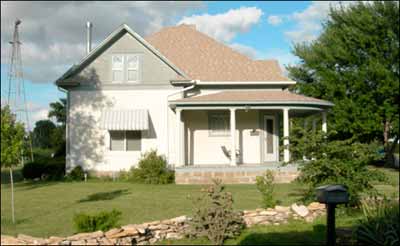
This is the house Harry Lewis lived in, photographed 30 years after his death. [August 13] A lot of kids grew up fearing Harry Lewis. He lived on the northeast corner of Centre Street and Bismark Avenue, in the house with the round porch. He was rarely seen, which made him all the more mysterious, but we kids all knew he hated for anyone to be on his lawn. I met Harry once as I tagged along with Dad on some carpentry project. He probably wasn't mean at all; legends grow out of proportion to the gesture that prompted them. I am certain now that he would have good stories. Harry's house has a different amily these days, and it's not overgrown and intimidating anymore. The skeleton of the old windmill is still out back, a remnant of the earliest 20th century. Harry was a railroad man and had been with the post office. He died on the last day of January 1977, and he's buried by himself under a cedar next to his parents, William and Della Lewis, at the Pawnee Rock Cemetery. William Lewis was one of this area's settlers. As you can read below in the excerpt from the "Biographical History of Barton County, Kansas," he was an important man in the local grain industry. Knowing that William Lewis farmed west of town also explains why the Logan & Lewis elevator (just the Lewis elevator after 1908, when he bought out D.R. Logan's interest) was the westernmost in Pawnee Rock. 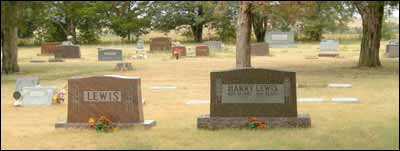
William, Della, and Harry Lewis are buried in the northern half of the Pawnee Rock Cemetery. William M. Lewis"Among the old timers of Pawnee Rock and Barton County, none is better known than William M. Lewis who came to this part of the state in 1874. He was born at Morrison, Illinois, April 12, 1862, and came here with his parents when he was twelve years of age. His father located a homestead two miles west of Pawnee Rock and began the work of developing the soil. "William attended school in this county and when he was twenty-one years of age began farming near Pawnee Rock. He farmed for six years and then accepted a position with the Santa Fe Railroad Company, and was with them for twelve years. One year of this time he was employed in Rice County and the remainer of the time was agent at Pawnee Rock. In 1900 he left the railroad company's employ and established a grain elevator at Pawnee Rock which he has operated since that time. The elevator has a capacity of 10,000 bushels and when established was owned by the firm of Logan & Lewis, Mr. Lewis beoming sole owner in 1908. "Mr. Lewis owns 260 acres of land in Pawnee County which is worked by his boy, a fine residence in Pawnee Rock which contains eight rooms in addition to closets, pantries, etc., a number of town lots and private interests. He has served the town as mayor, has been a member of the council, police judge and has been one of the most popular citizens of the town, always standing for its best interests and advancement. "He was married in this county June 6, 1884 to Miss Della Hall and they are the parents of four children: Edna, 27 years of age, is now the wife of Dr. Button of Great Bend; Harry, 25 years of age, is in the postal service; Charles, 23 years of age, is farming on his father's land near Pawnee Rock and Ruth, 20 years of age, is living at home. "Mr. Lewis is one of the men who came here when the county was in its infancy as far as agriculture goes and has seen it grow from an almost barren waste to its president high state of cultivation." 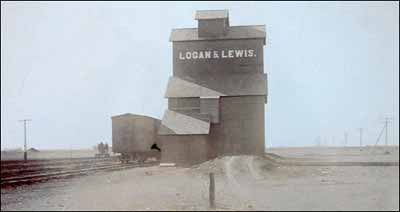
The Dennis Logan & William Lewis elevator before 1908. The barbecue boys The big iron kettle, retired to a corner of the yard and resting on its side, once held the place of honor where the wagon-wheel sculpture is this photo. The big iron kettle, retired to a corner of the yard and resting on its side, once held the place of honor where the wagon-wheel sculpture is this photo.
[August 12] I spent a little money yesterday and bought a cut-up chicken, pork chops, and hotdogs. There's no sense in letting a good day go to waste, and Saturday was a blue-sky day made for barbecuing. While the boys expanded their earthworks in a back corner of the yard, I got the grill ready to go. The boys lit the starter fluid, and despite my tough warnings tossed in some bark chunks and twigs while my back was turned. We didn't do a lot of barbecuing when I was a kid. As I remember it, we did cook hamburgers and hotdogs a handful of times on an old iron kettle in the back yard. I think the kettle, shaped like a half-sphere and originally hung from supports over a fire, had been used early in the century for industrial things like making soap and held probably a hundred gallons of liquid. I used to feel the same excitement Sam and Nik do now when there's an outdoors fire. I'd hunt for sticks and leaves and incinerate them when the folks looked elsewhere. In Pawnee Rock, we put a refrigerator shelf over the grill to cook hamburgers, or we'd skewer hotdogs then marshmallows with unwound coat hangers that we had burnt the paint off of. Our fires burned elm wood; charcoal was of no use in that cavernous kettle, and anyway it would have been a needless expense when nature's own fuel littered the yard. And that was barbecue, for all I knew. Eventually I went to the University of Kansas and met people from other towns, in particular Kansas City. Gary Vice was a senior and took me under his wing when we both worked for the University Daily Kansan and were sports correspondents for competing big-city dailies on the side. One fall day on our way to cover the Royals and Yankees in the playoffs, he drove us into KC and parked at Arthur Bryant's barbecue house. It was an alien world for me. I wasn't used to seeing many black people and certainly had never been in such a formica-based restaurant where you stood in line to order at the counter and even had to specify whether you wanted sauce. The orange-colored sauce, spicy and sweet, wasn't anything like we'd have back home, which meant that it was nothing like ketchup. So I was hooked, even though I never made it back to Arthur Bryant's. When I moved to Austin after college, I ate barbecue a couple of times a week. Roadside BBQ stands became my lunch counter, and the sugary, punchy sauce was my nectar. 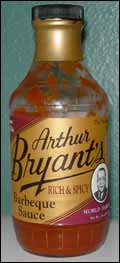 Where we live now, however, barbecue is a distant memory. There are a couple of barbecue places in town, but neither is what you would favorably call a "joint." One of them doesn't even cook brisket. So I slow-cook in the back yard. But there are still bits of the Midwest to be had. A few months ago, Julie Wright, one of the editors of the paper where I work, went back to her ancestral home, Kansas City, and brought me back a jar of Arthur Bryant's sauce. I had just about cleaned it out, but there was enough for yesterday's grilling. Late last night I went downstairs and found 11-year-old Sam working his way through a leftover drumstick and breast. I harrumphed like a good parent, but I knew how he felt. Fire plus chicken plus sauce equals a meal that's worth eating anytime. Sam doesn't put it in these words, but he's learning the secret of barbecue: Good meat by itself is tasty, but the truth is that meat is foremost a sauce-delivery platform. A photo I like: No. 47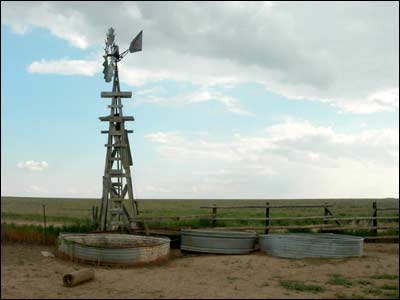
[August 11] I took a detour from K-4 last August as I drove west toward Colorado. Somewhere beyond Healy, I turned north on a small road and a mile or so up found this windmill off to the side. Ever since boyhood I've photographed every wooden windmill I've found; they're my favorite monuments to the early times. This one was still working, freshening two of its tanks for the cattle. The air was soft and dry, and the meadowlarks flitted from fencepost to fencepost, a trill here and a trill there. If I didn't already know how hard it is to be a farmer, I'd have bought 40 acres of this dusty paradise immediately. About the late Schmidt and Kopke[August 10] Yesterday I raised a couple of questions about two folks who had recently appeared in the obituaries: Eileen Schmidt and Warren Kopke. Answers came from loyal readers Anita Byers of Arkansas and Brenda Jones of Great Bend. Thanks to you both. Eileen Schmidt was married briefly to one man and then married Jacob, the younger brother of Roland, who lived north of Dundee. "When they were first married they lived in a small apartment, I think it was upstairs over the dress shop, but I don't remember the building being that tall," Anita wrote. (Maybe it was the building next door, a couple of doors west of the post office.) "I think she taught in PR high school one year, then moved to Great Bend." "Warren Kopke was probably the son of the man you mentioned," Anita wrote. "His father was dead by the time I heard of him, but his mother was living in PR when he became a lawyer." Brenda, who lives in Great Bend and is the daughter of Herman and Juletha Unruh Fox, knew Warren Kopke. "You had mentioned Warren Kopke on your website and he went to school with my mom (Class of 1942) and he went to our Church and he also was my Dad's attorney until he retired. What is odd is that Warren died the same day my Mom did only 27 years later. I thought it was odd that they went to school together and both died on the same day just years apart. "I think that his parents or some relatives are buried in the Pawnee Rock Cemetery because when I would go out to put flowers on Mom and Dad's grave I would see him and Dorothy out there putting flowers on some graves." 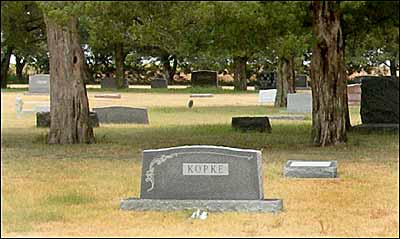
Otto and Josephine Kopke's family marker, in the northern part of the cemetery. Son Warren has been buried in the Great Bend cemetery. 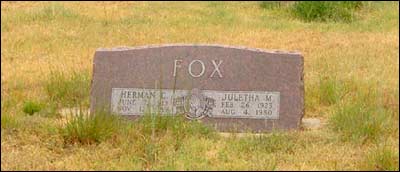
Herman and Juletha Fox's family marker, a few yards west of the Kopke marker. Dollar Night at the depot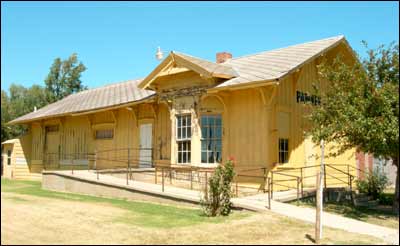
[August 9] Set aside your folding money now for next Thursday evening's Dollar Night at the depot. One dollar will buy you a hamburger or a hot dog or a brat or a salad. Four dollars will buy you one of everything. And then there will be free homemade ice cream, which all by itself would be worth standing in line for. The August 16 event is being sponsored by the park committee, which is raising money to improve the city park and for related cheerful things. Councilman Gary Trotnic, who sent this information, says that all the profit generated Thursday will go for Christmas lights at the park. Gary hopes to make Dollar Night a monthly event -- so be there and be square. At least, you'll get a square meal. Gary also writes: "I am also thinking about getting some banners that you hang on street poles that say welcome to 'Pawnee Rock' and maybe have a picture of the rock in the middle of it. Or something like that. If any one has any suggestion, they can e-mail me at gtrotnic@yahoo.com. Obituaries: Does anyone remember a teacher named Eileen Addis Schmidt? An August 7 obituary in the Great Bend Tribune mentioned that she had taught here for a while. Just below Mrs. Schmidt's obit is one for Warren Kopke. Does anyone know whether he was a son of the Kopke who was involved with elevators and ran the consolidated scale for a time? Hot child in the city: In a tribute to the bliss of summer, Cheryl Unruh wrote a column about some redneck fun she remembered from growing up in Pawnee Rock. And here she is reading it out loud on Kansas Public Radio. And here she is in KPR's electronic newsletter. Sure, Cheryl's famous and a great observer of Kansas life. But I'd like to point out that I knew her when she didn't have 20 words to string together. This is us playing on our front yard in Pawnee Rock; you may recognize the house on Santa Fe and the tin shed behind the fire station, which was there even in 1960. 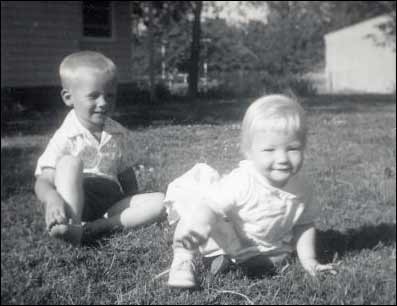
Farmers and Merchants State Bank, 1912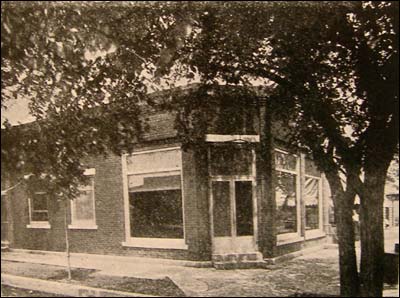
The Farmers and Merchants State Bank, as photographed in 1912 for the "Biographical History of Barton County, Kansas." To the right of the bank, Notice the steps down to the basement below the building next door (perhaps even then a drugstore), and the molded concrete blocks of the blacksmith's shop at the far end. 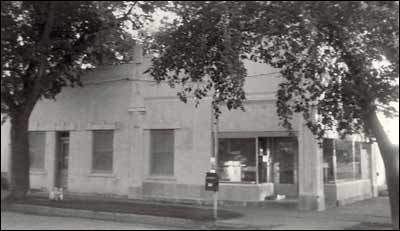
The post office, 1965. [August 8] We are lucky to have the remains of one of our banks preserved in Pawnee Rock. The Farmers and Merchants State Bank, one of two banks present in the early part of the 20th century, was housed in what is now the post office. The bank went out of business apparently during the Depression; I'm still looking for the date and cause. The building was constructed expressly to be a bank, according to the "Biographical History of Barton County, Kansas." It's easy to imagine a pair of teller's windows where the postal windows or mailboxes are now, and a manager of the bank sitting in the back. As you imagine it, remember that the back wall of the bank was about where the rural carrier has her table. The vault, according to the painting on the lower inside of the door, came from the American Bank Protection Company of Minneapolis, Minn. An all-American eagle is painted at eye level. The vault now is used as a storage room. The photos of the vault include the fancy tilework that made up the bank's floor. Among the bank's officers were some especially notable men: D.R. Logan and T.H. Brewer. Dennis Logan ran a dry-goods store and has a large family stone at the cemetery. Tom Brewer, who had four daughters owned extensive property and had a feed mill in town. Logan (1872) and William Bowman (1874) were here from the earliest days of settlement. The post office at the time the "Biography" was written was in the Francis and Heynes Drug Store a half-block south. 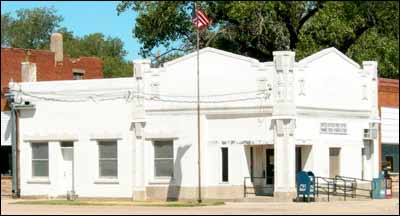
The post office, 2006. The town's other bank, Pawnee Rock State Bank, was discussed yesterday. Here is what the "Biographical History of Barton County, Kansas" had to say about the bank: Farmers and Merchants State Bank"Towns and cities are often judged by their banking institutions, and in the Farmers and Merchants State Bank of Pawnee Rock, the people of that section of the county have an institution that meets every demand made up on it, and by straightforward business methods has gained a most enviable reputation in all parts of Barton County. 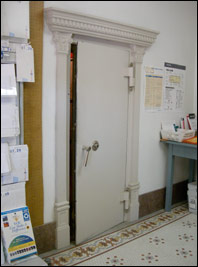
"This bank was organized in 1908 by gentlemen who have had a great deal to do with the development of the county's resources and the upbuilding of Pawnee Rock. This bank was organized with a capital of $15,000 and the deposits have grown larger each year and when the April, 1912 statement was issued it showed a total of appoximately $132,000, the capital and surplus at the same time being $20,000. This bank occupies a fine brick building in the center of town. The building was arranged especially for banking purposes and contains modern, up-to-date fixtures. The latest style Manganese steel vault assures the safety of all money and valuables left at this bank. All the safeguards that are usually found in a progressive banking establishment are maintained by this establishment, and in addition to this the deposits are guaranteed by the Bank Depositors' Guaranty Fund of the State of Kansas. 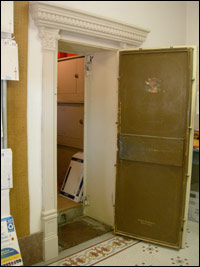
"This is a strictly home institution, all the stock in the bank being owned by men who have made this section of Kansas one of the most important in the state. The officers of this bank are men who stand high in the commercial and financial life of Barton County and are known for the progressive methods and public spiritedness. Customers of this bank are granted every accommodation that is consistent with safe banking methods. "The officers of this bank are: H.H. Woodbury, president; D.R. Logan, vice-president; F.C. Woodbury, casher. The directors are: W.H. Bowman, T.H. Brewer, G.F. Spreier, and H.H. Woodbury. This bank has won its high standing in the county by conducting a general banking business according to the most approved meethods, and by making of the establishment a bank for all the people of the territory adjacent to Pawnee Rock." Pawnee Rock State Bank, 1912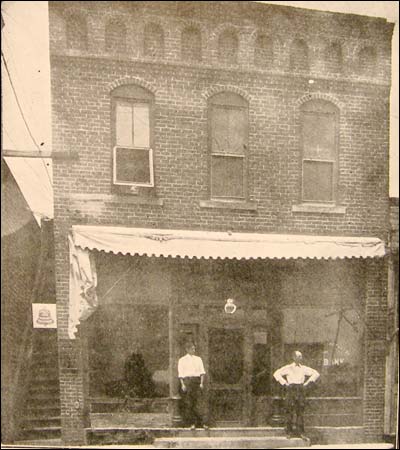
Pawnee Rock State Bank, as photographed in 1912 for the "Biographical History of Barton County, Kansas." [August 7] The two-story brick building that once contained the Pawnee Rock State Bank stood about where the depot does now, in the middle of the block along Centre Street. Although the town was the same geographical size it is now, it was more of an economic powerhouse with a double row of businesses on Centre Street and several elevators. 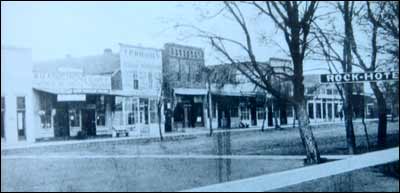
The Pawnee Rock State Bank sat on the west side of Centre Street. (In the photo, notice the row of elms growing next to the sidewalk on each side of the street.) The bank seems to have been shuttered during the Great Depression; I'm looking for the date. The buiding lasted until the 1960s, when it was torn down, the basement filled in, and town kids hired to clean the bricks for reuse. At the time the following paragraphs were written in 1912, Pawnee Rock had been settled for 40 years. Here is what the "Biographical History of Barton County, Kansas" had to say about the bank: Pawnee Rock State Bank"Barton County is noted for its sound, substantial banking institutions and there is none that stands better with the people of the county than the Pawnee Rock State Bank which was organized in August, 1901. It was the first bank in the town and was made possible by E.R. and G.N. Moses, Robert Merten, Peter Bloom, Charles Gano, J.T. Kell, M.E. Heynes and other well men who took a leading part in the commercial life of the county. All of the organizers with the exception of the first two named are pioneers of Pawnee Rock while the Moses Brothers helped develop that party of the county lying closely adjacent to Great Bend. "The bank was organized with a capital of $5,000, which has been increased to $25,000 from the earnings and not by assessment of the stockholders. It now has a surplus of $3,000 and deposits of approximately $95,000. The bank has grown steadily since it was organized and has gained the confidence of its patrons by square deal methods and untiring efforts in meeting every demand made upon it by custoemrs. The bank occupies a fine brick building on the Main street. It has a monder steel lined vault, which contains the latest improved Manganese steel safe and as additional protection the bank is equipped with an electric burglar alarm system which renders it absolutely impregnable to burglars. On top of all this the depositors in this bank are secured by the Bank Depositors' Guaranty Fund of the State of Kansas. "This bank offers exception advantages to new depositors. It pays liberal interest on savings and time deposits and grants to customers every favor that is in keeping with safe banking methods. These features have made this bank popular with the people of Pawnee Rock and vicinity and is a great aid in teaching the young people that the only dollars worth two hundred cents are those saved in youth. "The officers of this bank are: E.R. Moses, president; Peter Bloom, vice-president; A. Dring, cashier and A.S. Gross, assistant cashier. The directors are E.R. Moses, Jr., J.T. Kell, E.R. Moses, Peter Bloom and Robert Merten. All of these are men who enjoy the utmost confidence of the people of Barton County as they are among the men who made this county one of the best in the State of Kansas and are well and favorably known in the commercial and financial life of the state. This bank has enjoyed its growth from the fact that it is a home institution officered and owned by home people and conducted for the people of Pawnee Rock and this section of the county. The success of this bank is due to the enterprise of its stockholders and offcers who have gained the confidence of the people." A little more about the bankersBesides what was written in the county biographical history, I can give you these facts: The Moseses also owned an elevator in Pawnee Rock. Peter Bloom, you may remember, is the great-grandfather of Ruth Ann French Sessions, who wrote about the house Bloom built on Bismark Avenue at Houck Street. In the early 1900s, Bloom owned the Bloomdale Shorthorn Durham Stock Farm, a mile east of Pawnee Rock and south of the tracks. Charles Gano was an elevator man and the father of George Gano, who moved to Hutchinson and created a grain-handling business empire in western Kansas. The Gano elevator in Pawnee Rock was removed in the 1970s. Kell operated a store two doors north of the bank. The office of the local telephone company was on the top floor of the bank. Next, we'll look at the other bank in town. Pawnee Rockin' Days: Perhaps Pawnee Rock's August festival isn't dead yet. Konny Trinka, the event's sparkplug, told councilman Gary Trotnic after Monday's meeting that she'll try to pull the thing together again next year. Nobody asked for help, but I imagine that a donation of a few dollars or a few hours of volunteered time would help a lot. Trail race is coming[August 6] Clear your calendar on September 10 -- the Great Santa Fe Trail Horse Race endurance ride will be passing through Pawnee Rock. The race, from Santa Fe, New Mexico, to Independence, Missouri, will pause for a veterinary checkpoint north of the Rock, writes councilman Gary Trotnic. The action is expected to occur around noon. In addition, something called the Santa Fe Trail Pony Express will stop at the post office around 10 a.m., and the post office will offer special cancellations. Teams from several states are going to leave Santa Fe on Labor Day (September 3). You can be a volunteer as well as a groupie. The festivities in Pawnee Rock will include food, as all good festivities do. Look for homemade root beer, roasted corn and fried pork rinds, hot dogs, brats, and homemade ice cream. Locally, the riders will wake up that morning in Larned and go to sleep in Lyons. Off the Rocker: Pawnee Rockin' Days, a mid-August festival for several years, is being abandoned. Gary wrote, "We will try to get something going for next year but it will be called another name." If you have suggestions for the council or would like to volunteer, give a shout to anyone on the council or the clerk. Santa Fe Trail ruts[August 5] Pawnee Rock gets a good ride in Amy Bickel's story about Santa Fe Trail ruts today in the Hutch News. Thanks to Larry Mix, our man at the Santa Fe Trail Research Site, for bringing this to our attention. Where's good luck when you need it?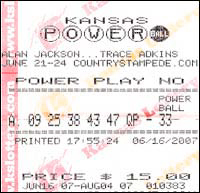 [August 5] Someday I will buy a big piece of property in Pawnee Rock, and I will give enough money to the town to build a swimming pool if it wants to. I will give everybody in town a gallon of homemade ice cream. I will put up the money for a scholarship for Pawnee Rock kids. I will buy books for the library. I will open a restaurant with very good food and reasonable prices. . . . Whenever it's possible, I buy a set of PowerBall numbers that will last 15 drawings. In my quest to win, I make all sorts of promises in the hope that it will persuade the Fairy of Good Fortune to tap my shoulder. As for now, however, I must report that my numbers expired last night and left me unfortuned. This week you'll have to buy your own ice cream. Mom at the window: My sister, Cheryl, read yesterday's entry about the backyard bamboo and observed how well a sound can carry across the years: "You mentioned the kitchen window where Mom looked out," Cheryl wrote. "I can still hear the sound of her tapping on the glass -- which either meant 'stop what you're doing!' or 'come in, supper's ready.'" A photo I like: No. 46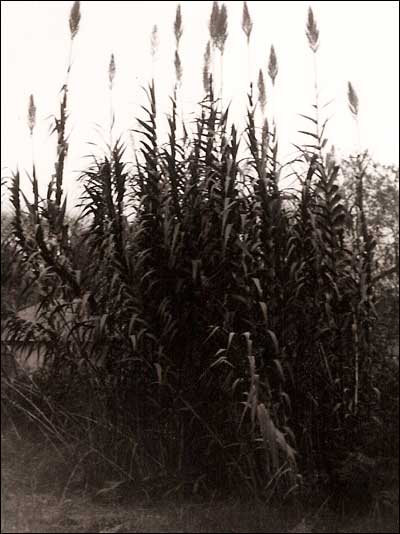
[August 4] This stand of bamboo grew in the back yard of our house on Santa Fe Avenue. The folks loved to experiment with gardening, so we had pampas grass, fruit trees, cactus, tiger lilies, and other botanical delicacies. It's not that bamboo was delicate; in fact, it was a plant suitable for the rough play of children. The leaves were like any grass' in that they would slice the skin of an uncareful child, but the seed-carrying tip-top of the stem was silky. When the stalks dried in the fall, we used them as javelins and as cross-bars for our high-jumping and pole-vaulting schemes. When we burned them, we listened for the whistle of steam escaping from the hollow center. Split open with their membranes intact, they made tipsy boats for sailing down the ditch after a big rain. Behind the bamboo was a wire fence common to yards in Pawnee Rock, and we kids cleared out a little nook by sitting on the unmowed yard grass that grew back there. Although anyone walking down the alley or standing in Gene Bowman's, Tom Flick's, or Gerald Ross' yards could see us, we imagined a zone of privacy existed because the bamboo stood between our little spot and the kitchen window, where Mom would most likely look out. Seventh-grade names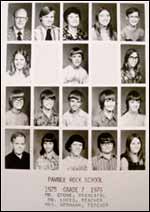
[August 3] Laramie Unruh of Valley Center recognized most of the kids in the Pawnee Rock seventh-grade class of 1975-76, which recently appeared on the homepage. (I put the names with the photo in the Gallery.) "This was my class, the year I started attending Harrison Junior High in Great Bend," he wrote yesterday. Laramie and his folks lived northeast of Pawnee Rock, so it made sense to switch to junior high in Great Bend, where he would be attending high school too. Below is a photo Laramie sent of this summer's backyard sunflower crop. 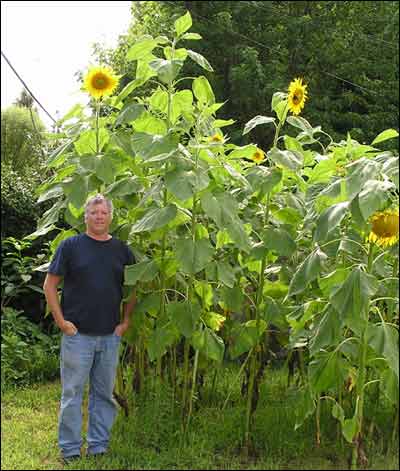
U.S. 56 by another name: Leon Miller of Dallas offers us a slice of highway history: "You had a picture of a sign that read U.S. 56. I wonder how many of today's generation knew that U.S. 56 was originally U.S. 50N, which stood for U.S. highway 50 North? "Kinda like the two routes of the Santa Fe Railroad; i.e. the original 'mainline' following the Arkansas River through Great Bend and Pawnee Rock, and the 'cutoff,' which went on a more direct route from Hutchinson to Kinsley." Delivery down the Santa Fe Trail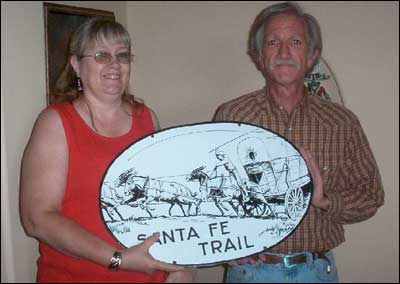
Alita Felts hands the prize sign to the buyer, Robert. [August 2] Gary Trotnic recently sold a historical Santa Fe Trail highway sign to a buyer in New Mexico. That was only part of the fun. "We took a little trip to Santa Fe and delivered the sign to him in person," Gary wrote. "We didn't want to take a chance on it getting lost in the mail." Well, Gary, I'd look for any excuse for a trip to Santa Fe, too. Gary also sent a brief photo history of later Santa Fe Trail highway signs. The green sign on the left is a sign we may all remember. Next to it are a smaller version of the sign and its flip side, showing the highway number. Finally, there's a shot of the sign that now appears along the trail. 
About Cobb Miller: After reading yesterday about Cobb Miller's life as a Mobil jobber, Rita Wade of Gem wrote: "What a wonderful story about an obviously wonderful man. Not only was he determined, but willing to ask and accept help from those in the community. Often times I think we (at least me) lack the determination to try and try again, but also I'm a bit hesitant to ask for help and accept others good will and 'good' dollars. We're an independent bunch in Western Kansas and admitting we need help and then trying again and again is hard to do." 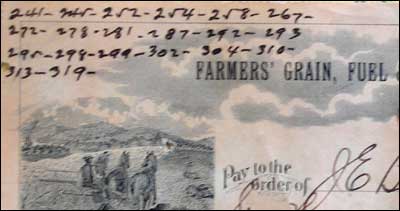
J.E. Bowman's check: Last week (and I'm really late posting this), Virgil Smith wrote about the Farmers' Grain check for $681.75 that now is pictured in the photo gallery. "The check from Farmers' Grain, Fuel & Livestock to J.E. Bowman, signed by W.W. Bowman, fascinated me," Virgil wrote. "I was fortunate to know both of these gentlemen, and another brother, Earl, lived across the intersection where we lived. All were getting quite old. I began doing income tax preparation in 1954. Starting with Norm Converse in the room behind the post office and then on my own in this room and later in the basement office in my home. I put in many long, late hours, but, in doing so, I got to know many of the early residents of Pawnee Rock. "I may be wrong, but I think that each of the twenty numbers in the upper left-hand corner represented a wagon-load of wheat delivered by a team of horses and the check was for the total payment of all of the loads. I can remember my father selling wheat in the 1930s for $.50 per bushel. In the days of this check, this would have been a lot of money and may be why it was kept as memento. I know that early cars cost considerably less than $1,000." The history and tragedy of Cobb Miller
Cobb Miller's fuel tanks sat east of the Farmers Grain elevator and south of what is now U.S. 56. This image combines two views to show the site of the tanks. [August 1] A few days ago, PawneeRock.org featured a homepage photo of the view southeast of the big Farmers Grain elevator. The following e-mail arrived shortly from Leon Miller: If you could visualize a spot about the middle of your picture [looking southeast from the elevator], about an inch from the bottom and near the end of the railroad spur tracks you would have had Cobb Miller's bulk plant, which consisted of 5 fuel storage tanks plus the pump station where the fuel was loaded into the delivery trucks. Immediately across from the pump station was a warehouse where barrels of oil and grease were stored for delivery to customers. My curiosity was piqued about the tanks because Pat Croff recently told me her memories of the big fire in 1942 at the Mobil tank farm in Pawnee Rock. She said that the unsung hero was a man who was considered a drunk -- he had closed off a valve and kept the fire from becoming worse. The fire and aftermath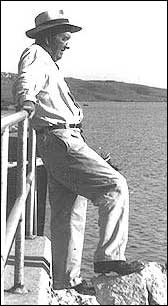
I asked Leon, the son of Mobil jobber Cobb Miller, for his memories of the day the tanks burned. (Cobb Miller appears in a vacation photo from the 1950s; the photo was made by Dean Ross.) Leon responded: As to my Dad's bulk plant (as he called it), it was on the south side of the highway. It was maybe 150 yards east of the large Farmers Grain Elevator. There were 5 upright tanks that contained various types of fuel, i.e. regular gasoline; ethyl, or high octane gasoline; "white" gasoline; diesel fuel; and heating oil. In the late '30s and '40s Dad would change out the diesel fuel for kerosene as some people used kerosene stoves to cook on. The "pump house" was a metal building on a 4 ft. platform that had a series of pipes and motors that pumped the fuel from the tanks into the truck tanks that would pull up to the dock. As best as I remember this fire Dad had occurred in November 1942. He had just received a contract to supply fuel to the contractors building the runways at the Great Bend Air Base. He worked a deal with his best friend, Pat Salyer, who had a similar operation in Larned, and together, they proceeded to deliver fuel to the builders of the air base. Late one afternoon, as they were loading fuel into Pat's truck a spark that apparently occurred when they were moving the supply line from one tank to another (the truck's tanks were divided into various size compartments in order to make deliveries to several customers on the same trip) caused an explosion that started the fire. The explosion blew my Dad off the platform and he was lucky to received only a cut on his forehead plus some bruises from the fall. I was home with my Mother and sister when we heard the town fire bell ringing. We went outside and could see this big ball of black smoke coming from the northeast. We got in our car and headed for the area of the fire and when we got a block from our house we noticed this decrepit man covered with dirt and soot, walking south on Centre Street. As it turned out it was my Dad. He had spent his whole life getting his business to this point only to have it blow up in front of him when it was just getting off the ground. But somehow, some way, he recovered and went on to spend his whole life in Pawnee Rock, serving the community both as a businessman, as well as being the Mayor in the 1950s. Sadly, looking back on his last 6 months (he died 40 years ago this month), I think he was consumed with how he would live out his remaining years as he was the epitome of the "company man"; living, breathing and giving his all to Mobil, only to have them desert him in his final days. What happened was that without any warning, Mobil sent him a registered letter giving him 90 days' notice that his lease on his bulk plant would be terminated and he would be without any further means of income. He had dedicated his life to them but to them he was no more than a fly on the wall. That played a vital picture for my life style as I never tried to work for a large corporation and started my business in 1967 as I thought the firm I was working for at the time, (Harwood K. Smith and Partners, which later became HKS Architects) was getting too large (30 employees) and I desired the smaller homey atmosphere. I'm sure you're aware, Mobil eventually left the state entirely as well as most of the plains states. Supposedly, they were confronted with some sort of disagreement with the State of Kansas, and rather than capitulate, decided to withdraw all their operations from the state. I think this happened sometime in the late '70s. Mobil tried to make everyone see things their way and eventually ended being bought out by Exxon. At one time they were on top of the world. Now, for all intents and purposes, they've been buried with other kingpins who ignored the little guy that put them where they were in their prime. The cost of becoming a jobberLeon later added some background about how Cobb got his dealership. It's a testament to the faith that Cobb Miller and the town of Pawnee Rock had in each other: The story that I've kept mostly to my family about my father's business aspirations goes like this: Dad was an agent for nearly 20 years for Socony Vacuum Oil Company, the forerunner of Mobiloil and Mobilgas. He started working as an agent after he married my Mother in 1923. In 1941 Dad wanted to become a jobber, which in essence was to be an independent retailer selling Mobilgas and Mobiloil on his own (which he eventually did). He contacted his sales representative to help him get started and together they put a plan together to approach Mobil for acceptance as being a jobber. Mobil was extremely protective of their jobberships and on extremely rare occasions would give one out. But Dad was determined to go ahead and get one of these. He and his rep went to Mobil's regional headquarters in Kansas City, to meet with those in command and get the "rules" as to what they had to do to get the jobbership. First, Dad had to get all his bills collected and paid up, which he did. Then they gave him a requirement that necessitated an investment, in today's dollars, of $50,000. He met that. Then they came back, upping the ante to $200,000 (again in today's dollars). They were pretty sure he couldn't meet that requirement so were ready to write him off. But Dad had some customers who believed in him and agreed to loan him the money to proceed. So he went back to Kansas City with the $200,000 commitment but Mobil reneged and gave him what they said was the final requirement: a $1,000,000 commitment. He came back home, totally drained, wanting so much to have his business but the company was treating him like some lowly animal. They were bound and determined he wasn't going to get the jobbership. Nevertheless, he went back to his customers and after praying over it, they agreed to back him. Mobil couldn't believe that he could pull this off but had to honor their commitment to let him have the jobbership. It lasted for 25 years and proved to be not only a profitable venture for Mobil but my Dad as well, plus being an inspiration to this writer to have the courage to face adversity despite formidable odds. |
Sell itAdvertise here to an audience that's already interested in Pawnee Rock: Or tell someone happy birthday. Advertise on PawneeRock.org. |
|
|